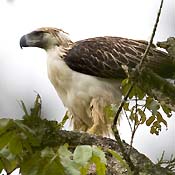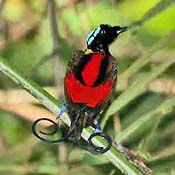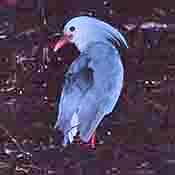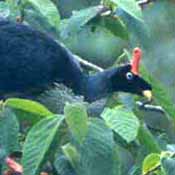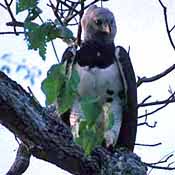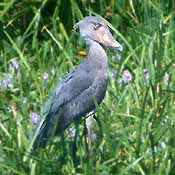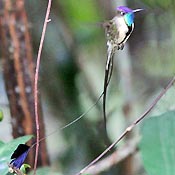# |
Species [range] |
Photo/art [see credits];
all photos taken in the wild |
Summary of reasons for this choice |
DR seen? |
1 |
Philippine Eagle
Pithecophaga jefferyi
[Philippines] |
|
The largest and most spectacular raptor in the world is also among the rarest — it is threatened with extinction as Philippine forests are destroyed. Perhaps less than 200 adults remain in isolated and difficult to reach forest remnants. "Seeing the Philippine Eagle" page has some personal experiences. I chose this as my #1 most wanted bird back in 1974, and it remains the best bird in the world. |
Yes |
2 |
Wilson's
Bird-of-Paradise
Cicinnurus respublica
[Batanta & Waigeo Is.; off w. New Guinea] |
|
Of all the incredible birds of paradise, none is more remote and spectacular than this species whose latin name commemorates the French revolution. Its bare crown glows neon-blue as the male performs on his carefully tended forest floor display site. An almost unbelievably wonderful bird to watch (which is not at all easy to do); see my "Birds of Paradise" page for a bit more. |
Yes |
3 |
Gray-necked Rockfowl
Picathartes oreas
[w. central Africa] |
|
Huge predators and gaudy passerines are wonderful, but few birds capture my imagination as the elusive ground-dwelling enigmas of tropical forests. None are more unique, impressive, and rare than the two rockfowl of Africa. The adventure to reach a cave in which they build mud nests is a peak experience of any life; see my "Rockfowl" page for much more about this fabulous central African bird, best searched for in Cameroon or Gabon. |
Yes |
4 |
White-necked Rockfowl
Picathartes gymnocephalus
[west Africa] |
|
Along with the Congo Peafowl (#10 below), African field ornithologists have long considered the two rockfowl to be the best birds of Africa. This west African representative is now very rare in the fragments of forest still extant; see my "Rockfowl" page for details on the many unique attributes of these picathartes. |
Yes |
5 |
Kagu
Rhynochetos jubatus
[New Caledonia] |
|
Once considered virtually impossible to see, this exceptional bird of very uncertain affinities is making a good recovery in the forest remnants due to predator removal and captive breeding. Still a shadowy ghost on the forest floor; see my "Kagu" page for more. Only a few hundred in the wild, it rates very high on uniqueness. |
Yes |
6 |
Horned Guan
Oreophasis derbianus
[sw Mexico & n Guatemala] |
|
This huge near-mythical guan lives only in remote cloud forests atop extinct volcanoes; the bare vivid red horn is completely unique. Even a 40+ mile trek to its habitat does not guarantee finding any; it took me two trips 16 yrs apart. Much more on my "Quest for the Horned Guan" page. |
Yes |
7 |
Harpy Eagle
Harpia harpyja
[s. Mexico to Brazil] |
|
The second largest eagle in the world and the king of the Neotropics, this is the ultimate prize on any New World lowland forest visit. Its range is widespread but it requires huge swathes of jungle full of monkeys to survive. It is everywhere thinly spread and thus missed often even in prime habitat; see my "Seeing the Harpy Eagle" page for more. |
Yes |
8 |
Spoon-billed Sandpiper
Eurynorhynchus pygmeus
[east Asia] |
|
Everyone's favorite small shorebird, the stint with the totally unique bill continues to be difficult to pin down. The world population is very small. It nests in remote Siberia, is scarce on passage on the Chinese coast, and winter in places like Vietnam or Bangladesh which have been difficult to visit, but a handful visit Thailand. For those who love wader migration, this has a world-class starring role. |
Yes |
| 9 |
Shoebill
Balaeniceps rex
[e. & c. Africa] |
|
A rare and rather shy specialist that feeds on lungfish in vast papyrus swamps, it is still usually considered as a monotypic family although recent evidence suggests it is a relative of pelicans. For years there was no reasonable place to visit in hopes of seeing one, but the tourist industry in Uganda now provides good opportunities. I saw it at Murchison Falls NP in 2002, but there is habitat close to Kampala as well. |
Yes |
10 |
Marvelous Spatuletail
Loddigesia mirabilis
[n. Peru] |
|
The hummingbirds include many spectacular gems. I pick the male Spatuletail for its spectacular tail, plus it is scarce and local, confined to the upper Rio Marañón Valley, n. Peru. There is now a lodge where it is predictably seen. One negative in picking a sexually dimorphic species is that the thrill of seeing a female or immature is just not the same thing as the male.... See a separate page on this incredible species. |
Yes |


